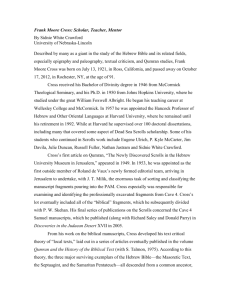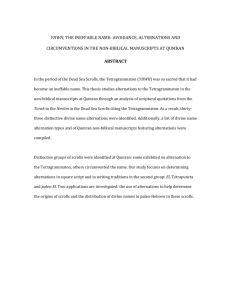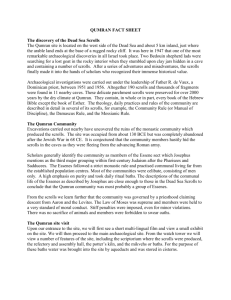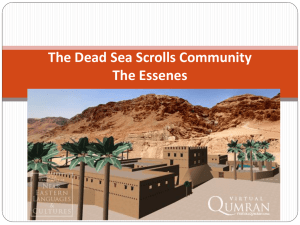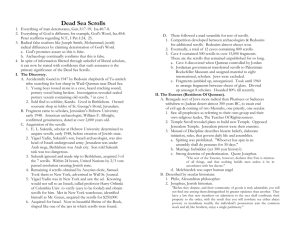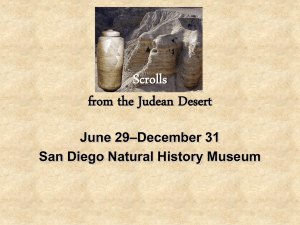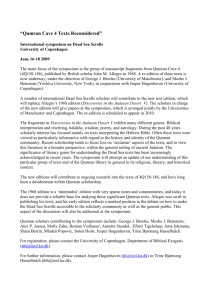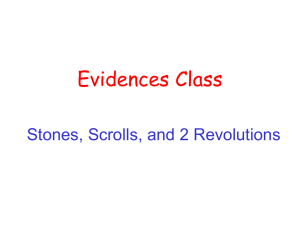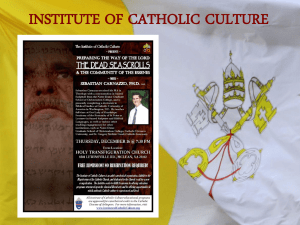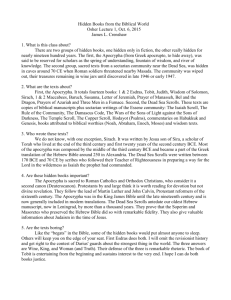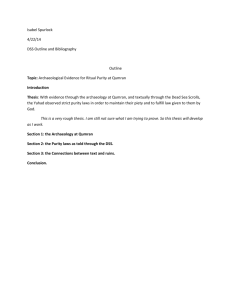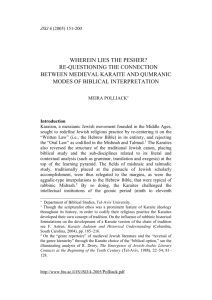The Dead Sea Scrolls
advertisement
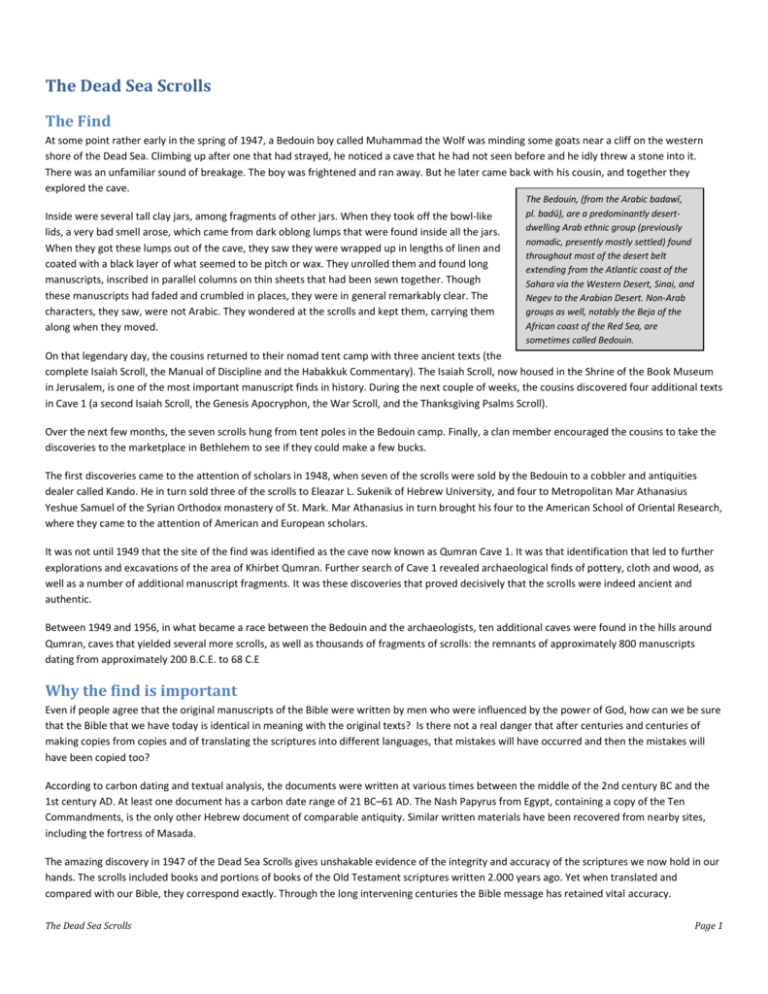
The Dead Sea Scrolls The Find At some point rather early in the spring of 1947, a Bedouin boy called Muhammad the Wolf was minding some goats near a cliff on the western shore of the Dead Sea. Climbing up after one that had strayed, he noticed a cave that he had not seen before and he idly threw a stone into it. There was an unfamiliar sound of breakage. The boy was frightened and ran away. But he later came back with his cousin, and together they explored the cave. Inside were several tall clay jars, among fragments of other jars. When they took off the bowl-like lids, a very bad smell arose, which came from dark oblong lumps that were found inside all the jars. When they got these lumps out of the cave, they saw they were wrapped up in lengths of linen and coated with a black layer of what seemed to be pitch or wax. They unrolled them and found long manuscripts, inscribed in parallel columns on thin sheets that had been sewn together. Though these manuscripts had faded and crumbled in places, they were in general remarkably clear. The characters, they saw, were not Arabic. They wondered at the scrolls and kept them, carrying them along when they moved. The Bedouin, (from the Arabic badawī, pl. badū), are a predominantly desertdwelling Arab ethnic group (previously nomadic, presently mostly settled) found throughout most of the desert belt extending from the Atlantic coast of the Sahara via the Western Desert, Sinai, and Negev to the Arabian Desert. Non-Arab groups as well, notably the Beja of the African coast of the Red Sea, are sometimes called Bedouin. On that legendary day, the cousins returned to their nomad tent camp with three ancient texts (the complete Isaiah Scroll, the Manual of Discipline and the Habakkuk Commentary). The Isaiah Scroll, now housed in the Shrine of the Book Museum in Jerusalem, is one of the most important manuscript finds in history. During the next couple of weeks, the cousins discovered four additional texts in Cave 1 (a second Isaiah Scroll, the Genesis Apocryphon, the War Scroll, and the Thanksgiving Psalms Scroll). Over the next few months, the seven scrolls hung from tent poles in the Bedouin camp. Finally, a clan member encouraged the cousins to take the discoveries to the marketplace in Bethlehem to see if they could make a few bucks. The first discoveries came to the attention of scholars in 1948, when seven of the scrolls were sold by the Bedouin to a cobbler and antiquities dealer called Kando. He in turn sold three of the scrolls to Eleazar L. Sukenik of Hebrew University, and four to Metropolitan Mar Athanasius Yeshue Samuel of the Syrian Orthodox monastery of St. Mark. Mar Athanasius in turn brought his four to the American School of Oriental Research, where they came to the attention of American and European scholars. It was not until 1949 that the site of the find was identified as the cave now known as Qumran Cave 1. It was that identification that led to further explorations and excavations of the area of Khirbet Qumran. Further search of Cave 1 revealed archaeological finds of pottery, cloth and wood, as well as a number of additional manuscript fragments. It was these discoveries that proved decisively that the scrolls were indeed ancient and authentic. Between 1949 and 1956, in what became a race between the Bedouin and the archaeologists, ten additional caves were found in the hills around Qumran, caves that yielded several more scrolls, as well as thousands of fragments of scrolls: the remnants of approximately 800 manuscripts dating from approximately 200 B.C.E. to 68 C.E Why the find is important Even if people agree that the original manuscripts of the Bible were written by men who were influenced by the power of God, how can we be sure that the Bible that we have today is identical in meaning with the original texts? Is there not a real danger that after centuries and centuries of making copies from copies and of translating the scriptures into different languages, that mistakes will have occurred and then the mistakes will have been copied too? According to carbon dating and textual analysis, the documents were written at various times between the middle of the 2nd century BC and the 1st century AD. At least one document has a carbon date range of 21 BC–61 AD. The Nash Papyrus from Egypt, containing a copy of the Ten Commandments, is the only other Hebrew document of comparable antiquity. Similar written materials have been recovered from nearby sites, including the fortress of Masada. The amazing discovery in 1947 of the Dead Sea Scrolls gives unshakable evidence of the integrity and accuracy of the scriptures we now hold in our hands. The scrolls included books and portions of books of the Old Testament scriptures written 2.000 years ago. Yet when translated and compared with our Bible, they correspond exactly. Through the long intervening centuries the Bible message has retained vital accuracy. The Dead Sea Scrolls Page 1 In November 1947 the United Nations Organization, sitting in the USA was engaged in deliberations which were to lead up to the ending of the British Mandate for Palestine and recommending the establishment of a Jewish State. Jewish intelligence reported that Arab attacks on Jewish cities and settlements were curtain to follow. It was in such a tense atmosphere that E. L. Sukenik, Professor of Archaeology at the Hebrew University received on Sunday 23 November, 1947, a message from a friend, an Armenian dealer in antiquities, asking the professor to get in touch with him immediately. A meeting was fixed for the next morning. The British forces had divided Jerusalem into military zones, each marked off with barbed wire barriers. Sukenik met the Armenian dealer at the gateway to Military Zone B. As neither of them had passes to go from one zone to another, their conversation had to be across the barbed wire. The dealer held up a scrap of leather; Sukenik strained his eyes to peer through the loops of barbed wire to make out the letters on the scrap. Gradually he recognized the shapes of the letters. They resembled those he had found on small coffins and ossuaries discovered by him in ancient tombs around Jerusalem and dating back to the period before Rome`s destruction of Jerusalem. At first Sukenik felt the writing must be a forgery but as he continued to peer the feeling grew stronger and stronger that this was no forgery but the real thing. The professor's initial doubts were understandable. Until the discovery of these scrolls it had been accepted by scholars that the survival of writing on leather or parchment for 2.000 years was an utter impossibility. In fact, because of this feeling, it appears a valuable scroll was lost in the 1880's. Moses Wilhelm Shapira offered for sale to the British Museum an ancient manuscript of Deuteronomy which he had found during his exploration of the area east of the Dead Sea, but it was denounced as a forgery by the experts at the time. There is a strong feeling now that it was a genuine document, rejected simply because the experts felt that no scroll dating back to the time of Christ could have survived. We can well imagine Sukenik's suppressed excitement as the conviction grew that the fragment he was gazing at was probably 2,000 years old. The dealer then told him that a mutual friend, an Arab antiquities dealer in Bethlehem, had told him that some Bedouin had called on him bringing several parchment scrolls which they said they had found in a cave near the Dead Sea shore, not far from Jericho. Sukenik made the perilous journey to Bethlehem. It was through Arab held territory and the seven Arab nations were about to attack Israel. After the usual long drawn-out preliminaries the Arab dealer produced three scrolls. Professor Sukenik records: 'My hands shook as I started to unwrap them. I read a few sentences. It was written in beautiful biblical Hebrew . . I looked and looked. and I suddenly had the feeling that I was privileged by destiny to gaze upon a Hebrew scroll which had not been read for more than two thousand years.' What they are The manuscripts of the Qumran caves include early copies of biblical books in Hebrew and Aramaic, hymns, prayers, Jewish writings known as pseudepigrapha (because they are attributed to ancient biblical characters such as Enoch or the patriarchs), and texts that seem to represent the beliefs of a particular Jewish group that may have lived at the site of Qumran. Most scholars believe that the Qumran community was very similar to the Essenes, one of four Jewish "philosophies" described by Josephus, a first century C.E. Jewish historian. Some have pointed to similarities with other Jewish groups mentioned by Josephus: the Sadducees, Pharisees, and Zealots. We do not know precisely who wrote those sectarian scrolls, but we can say that the authors seemed to be connected to the priesthood, were led by priests, disapproved of the Jerusalem priesthood, encouraged a strict and pious way of life, and expected an imminent confrontation between the forces of good and evil. The Qumran library has proven to be enormously informative. From these texts we have increased our understanding of the transmission of the Bible, we have learned more about the development of early Judaism, and we have gained insight into the culture out of which emerged both Rabbinic Judaism and Christianity. The Dead Sea Scrolls were discovered in 11 caves (5 by Bedouin; 6 by archaeologists) on the upper northwest shore of the Dead Sea. The area is 13 miles east of Jerusalem, and is 1300 ft. below sea level (Jerusalem is 2400 ft. above sea level). Near the caves are the ancient ruins of Qumran, which was excavated in the early 1950's and appears to be connected with the Scrolls. The Scrolls so far discovered represent a library of over 900 documents representing as many as 350 separate works in multiple copies, many of which are represented only by fragments. Cave 4 alone contained 520 texts in 15,000 fragments. The Dead Sea Scrolls Page 2 Biblical Manuscripts. About a fourth of the scrolls are copies, in whole or in part, of every book in the Old Testament except the book of Esther.1 An example is 1QIsaa The Great Isaiah Scroll, a scroll more than twenty-four feet long containing the entire text of the book of Isaiah. Among the documents found at Qumran are several copies of the same books of scripture, some of which were copied in ancient paleo-Hebrew, not the Hebrew script of the time. Some of the biblical texts from Qumran differ significantly from conventional wording and even among themselves. And there is evidence of additions and deletions in some texts, suggesting that in some instances scribes felt free to alter the texts they were working on. No list was found in this collection that would indicate which texts the community considered part of the Bible. Indeed, the evidence suggests that those at Qumran may not have had a clear notion of what constituted an authoritative collection of sacred books.2 However, other biblical manuscripts are very close to the text found in the Hebrew Bible, known as the Masoretic text, which was composed by Jewish authorities centuries later, between A.D. 600 and the middle of the tenth century. This consistency is remarkable because these manuscript copies are at least a thousand years older than previously known biblical manuscripts and even predate the canonization of the Hebrew Bible! This range of fidelity to the Hebrew Bible illustrates the fact that at this time several versions of the same biblical texts were in circulation and that views differed about which versions were more authoritative. Needless to say, it would be difficult to overestimate the value that some of these scrolls have had in present-day biblical studies. Parabiblical Manuscripts. This category includes copies of (1) apocryphal writings, or texts of questionable authorship or authenticity, and (2) pseudepigraphical texts, so designated because they have been determined to be spurious writings, falsely attributed to biblical figures or times. Sectarian Manuscripts. Writings in this category fall into three groups: those that describe what could be called the rules and regulations governing community life, those that are distinctive biblical commentaries, and those that are apocalyptic and liturgical works. The first group is represented by fragments from a work known as the Damascus Document (medieval copies of which were also discovered in Cairo in the last century and have now been identified with the Qumran community), 1QS Rule of the Community, and the Halakhic Letter (several copies of which were found, all containing, among other things, mention of twenty-two religious laws applying to this community). The second group includes commentaries on the teachings of the biblical prophets Habakkuk, Nahum, and Hosea. These commentaries differ from modern reflections on scripture because their interpretations of scripture reveal aspects of the group's history and future, along with its dealings with its leaders and adversaries, in a manner believed to be properly understood only by members of the community. Apocalyptic writings foretelling the ultimate triumph of good over evil are represented by such manuscripts as the War Scroll (technically The War of the Sons of Light with the Sons of Darkness), while liturgical works, along with hymns and psalms, illustrate the central importance of prayer and worship within the community. The Qumran collection of scrolls also includes miscellaneous material such as legal texts, contracts, and lists of names. Table of Contents Here is a brief list of the more popular Scrolls: 1QIsaa (a copy of the book of "Isaiah") 1QIsab (a second copy of the book of "Isaiah") 1QS ("Community Rule") cf. 4QSa-j = 4Q255-64, 5Q11 1QpHab ("Pesher on Habakkuk") 1QM ("War Scroll") cf. 4Q491, 4Q493; 11Q14? 1QH ("Thanksgiving Hymns") 1QapGen ("Genesis Apocryphon") CD ("Damascus Document") cf. 4QDa/g = 4Q266/272, 4QDa/e = 4Q266/270, 5Q12, 6Q15, 4Q265-73 1QSa ("Rule of the Congregation") 1QSb ("Rule of the Blessing") = 1Q28b 1Q14 ("Pesher on Micah") The Dead Sea Scrolls Page 3 2Q18 ("Sirach" or "Wisdom of Jesus ben Sira" or "Ecclesiasticus") 3Q7 ("Testament of Judah") = 4Q484, 4Q538 3Q15 ("Copper Scroll") 4QCantb ("Pesher on Canticles or "Pesher on the Song of Songs) = 4Q107 4QCantc ("Pesher on Canticles or "Pesher on the Song of Songs) = 4Q108 4Q112 ("Daniel") 4Q123 ("Rewritten Joshua") 4Q127 ("Rewritten Exodus") 4Q128-148 (various tefillin) 4Q156 ("Targum of Leviticus") 4Q157 ("Targum of Job") = 4QtgJob 4Q158, 364-367 ("Rewritten Pentateuch") 4Q161-164 ("Pesher on Isaiah") 4Q166-167 ("Pesher on Hosea") 4Q169 ("Pesher on Nahum") 4Q174 ("Florilegium" or "Midrash on the Last Days") 4Q175 ("Messianic Anthology" or "Testimonia") 4Q179 ("Lamentations") cf. 4Q501 4Q196-200 ("Tobit") 4Q213-214 ("Aramaic Levi") 4Q215 ("Testament of Naphtali") 4QCanta ("Pesher on Canticles or "Pesher on the Song of Songs") = 4Q240 4Q252 ("Pesher on Genesis") 4Q285 ("Rule of War") cf. 11Q14 4Q434 ("Barkhi Napshi - Apocryphal Psalms") (15 fragments likely hymns of thanksgiving, praising God for his power and expressing thanks ) 4QMMT ("Miqsat Ma'ase Ha-Torah" or "MMT" or "Some Precepts of the Law" or the "Halakhic Letter") cf. 4Q394-399 4Q400-407 ("Songs of Sabbath Sacrifice" or the "Angelic Liturgy") cf. 11Q5-6 4Q448 ("Hymn to King Jonathan") 4Q521 ("Messianic Apocalypse") 4Q539 ("Testament of Joseph") 4Q554-5 ("New Jerusalem") cf. 1Q32, 2Q24, 5Q15, 11Q18 7Q2 ("Letter of Jeremiah") = Baruch 6 11QPsa ("Apocryphal Psalms") = 11Q5 11QtgJob ("Targum of Job") = 11Q10 11QMelch ("Heavenly Prince Melchizedek") = 11Q13 11QSM ("Sefer Ha-Milhamah" or "Book Of War") = 11Q14. cf. 1QM? 11QT ("Temple Scroll") = 11Q19 The Dead Sea Scrolls Page 4
